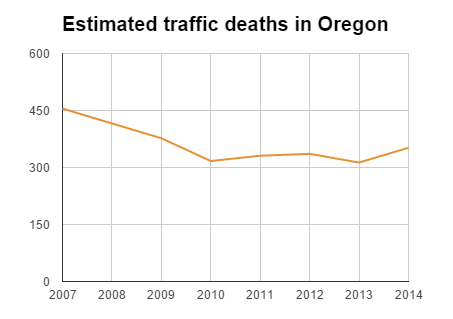One year after Oregon saw its best year for traffic safety since World War II, it seems to have backslid somewhat.
“We’re not trying to say this is all drivers’ fault, and all numbers aren’t in. [But] driver errors top the list…”
— Dave Thompson, ODOT
According to preliminary numbers compiled by the Oregon Department of Transportation, Traffic-related fatalities statewide rose 9 percent in 2014, to 352. That’s up from 313 in 2013. It’s the highest number since 2009.
Like the United States as a whole, Oregon made big and, so far, lasting strides toward better safety in the late 2000s; fatalities in Oregon fell 30 percent from 2007 to 2010, a much steeper decline than the partly recession-related drop in vehicle-miles traveled.
The modest but disturbing trend for 2014 held across every travel mode tracked by ODOT:
- 56 people died walking, up from 52 in 2013
- 45 people died on motorcycles, up from 34
- six people died bicycling, up from three
“We’re disturbed by every single one of these numbers,” ODOT spokesman Dave Thompson said Tuesday. “There’s always some sort of fluctuation, but the trend for years has been down.”
“That shows that all of us need to do a better job,” Thompson went on. “Us in terms of education, drivers in making sure they’re not driving distracted. We’re not trying to say this is all drivers’ fault, and all numbers aren’t in. [But] driver errors top the list: driving too fast for conditions, not using a seat belt, driving impaired, failing to yield right of way, passing illegally, inattentive driving have always been the main reasons.”
Advertisement
Thompson noted that ODOT’s analysts “have noticed an increase in distracted driving.”
“I don’t have any reasons for it,” he said. “That’s what I hear our experts saying.”
The number of miles driven by Oregonians also rose in 2014, by about 2 percent.
It’s good to hear Thompson noting that driver choices, important though they are, aren’t the only factor in crashes. (Like many state DOTs, ODOT sometimes seems institutionally blind to the notion that road design plays a role in encouraging driver error.)
This issue matters to people biking because of their vulnerability on the road, of course. But it’s worth noting that, of the many known solutions for increasing road safety — narrower streets and lanes, 4/3 road diets, cable freeway barriers — one of them is simply increasing the number of bikes on the road.
As Bike Snob writer Eben Weiss put it in the New York Times, bikes function “like bivalves helping to clean a polluted waterway.”
As we shared in the Monday Roundup yesterday, Denmark saw 170 traffic fatalities in 2014, its lowest figure ever recorded. Its population is about 50 percent larger than Oregon’s.
It’s timely that Oregon Walks and the Bicycle Transportation Alliance have teamed up to push for Vision Zero policies, which call for prioritizing safety over convenience in road design, at the state and city levels.
“Our goal is zero fatalities,” Thompson said. “And our fatality rate — not just the number of fatalities, but the number of fatalities per mile driven — that is below the national average. But still we can do better.”


